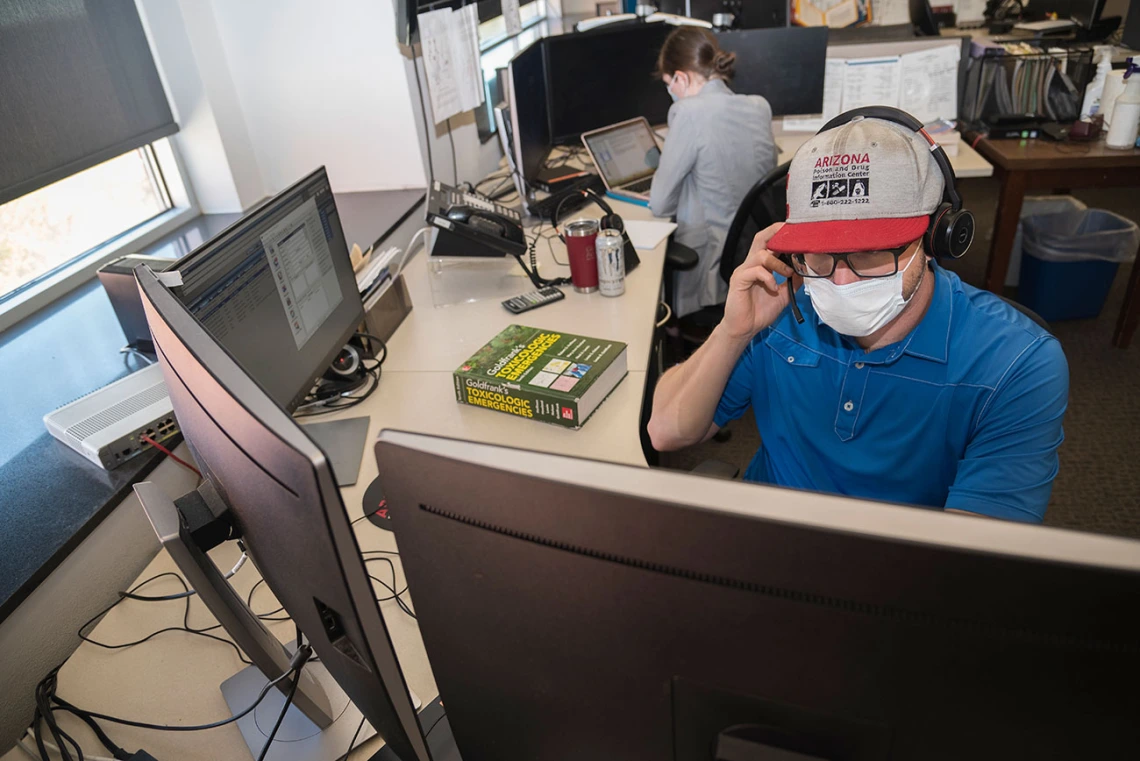A Day in the Life of the Arizona Poison and Drug Information Center
From accidental medicine overdoses to scorpion stings, see how a poison center answers the call (literally) to provide immediate life-saving information and medical expertise.

The phone never truly stops ringing at the Arizona Poison and Drug Information Center (AzPDIC).
At this very moment, specially trained pharmacists are fielding calls from concerned parents, worried adults and health care professionals working in hospitals and clinics across Arizona.
Located in the R. Ken Coit College of Pharmacy, the AzPDIC is one of 55 poison centers nationwide, providing free, confidential, 24/7 expert advice on poisonings and drug information. Except for Maricopa County, which has its own center, the AzPDIC has served every county in Arizona for over 65 years.
The five sample cases below represent a small fraction of the calls answered in a single day at the Arizona Poison and Drug Information Center.
6:05 a.m.: Common medicine mix-up
A mother accidentally gave her five-year-old child one pill of extra-strength Tylenol instead of Advil after becoming confused and mixing up the medicine.
Medicine mistakes happen. Experts at the AzPDIC perform quick calculations to determine if a medicine exposure is toxic.
Pain medicine, like Tylenol and Advil, is one of the top calls to the AzPDIC for children five years or younger. Besides medicine mix-ups, many medicines can trick children by looking and tasting like candy.
Keep kids safe by always reading the label and storing all medicine up and away, out of sight and reach in a locked area.
11:18 a.m: Scorpion sting
An emergency room doctor calls for help with a baby stung by a scorpion. The baby is thrashing, crying, and having leg spasms.
The AzPDIC specializes in treating all kinds of bites and stings and answers 900-1500 calls per year about scorpion stings.
The bark scorpion is the only potentially dangerous species in Arizona because of its neurotoxic venom. Luckily, the AzPDIC can guide treatment for over 84% of bark scorpion sting patients at home.
Young children are at the greatest risk for severe symptoms, like agitation, uncontrolled eye movements, muscle jerking, drooling and difficulty breathing. Early symptom recognition is critical for scorpion stings in children.
If given quickly, the antivenom, Anascorp, can help to prevent intubation (placing a tube into the airways to breathe) and a trip to the hospital intensive care unit (ICU).
Experts at the AzPDIC can help caregivers properly respond to a sting by identifying symptoms and determining if a trip to the hospital is needed.
2:08 p.m.: Accidental overdose on allergy medicine
A daughter is calling because her father accidentally took four Benadryl pills a few minutes ago.
Poison centers are not just for kids. We help adults. too.
With allergy season approaching, many people turn to allergy medicine, also known as antihistamines, to help treat symptoms. The AzPDIC has seen a 423% increase in calls about the antihistamine known as diphenhydramine between 2021 and 2022.
Diphenhydramine is the drug used in popular brands like Benadryl, and it can be dangerous if misused. Taking more than the recommended amount can lead to confusion, fast heart rate, blurry vision and hallucinations. In some cases, diphenhydramine overdose can cause life-threatening complications.
Unfortunately, many calls to the AzPDIC involve suicidal patients, so the scenario matters. Even if a dose isn’t technically toxic, a patient trying to harm themselves will be sent to the hospital to get the care they need from nurses and doctors.
To stay safe, remember that more is not better. Avoid doubling up on doses, and do not take two different antihistamines at the same time.
5:17 p.m.: Ingestion of poisonous plant
A nurse calling for assistance with a child that was found with an oleander flower in his mouth.
Spring showers bring May flowers, but poisonous plants are also in bloom. Oleander (Nerium oleander) is one of Arizona's most common poisonous plants.
The AzPDIC answers between 70-100 calls about oleander every year.
The entire oleander plant contains cardiac glycosides, which can cause changes to a person’s heart rate. The most common effects after eating or swallowing oleander include nausea, vomiting, stomach pain, tiredness and a slower than normal heart rate.
While oleander can be deadly if eaten in large amounts, serious poisoning rarely develops after small exploratory “tastes” by children.
11:35 p.m.: Too much melatonin
A middle-aged man called; he ate eight melatonin gummies a few minutes ago to try and fall asleep.
Melatonin is a hormone that occurs naturally in the body and is sometimes taken over-the-counter as a sleep aid.
Short-term use appears to be safe for most people, but melatonin is not fully regulated by the U.S. Food and Drug Administration. Some products may contain more than the amount of advertised melatonin.
Reliance on sleeping aids like melatonin may lead to adults using it at dangerously high levels. Some side effects of using too much melatonin include drowsiness, dizziness, headache and weakness.
If you use melatonin, make sure to read and follow label instructions. Natural doesn’t always mean safe.
In any of these cases, calling the AzPDIC at 1-800-222-1222 is the right choice. Save the number in your phone, or visit www.azpoison.com to request a free magnet or sticker for the house.
About the Author
Laura Morehouse, MPH, CHES is a certified health education specialist with interest in curriculum development, program design, and evaluation.
As the educator for the Arizona Poison and Drug Information Center (AzPDIC), she is available for presentations on poisoning prevention, venomous desert creatures, elder adult concerns, and as a resource for other toxic hazard concerns. Additionally, she is available for “Train the Presenter” programs catered towards healthcare professionals, community organizations, and adults that want to learn how to educate others about poison prevention.

